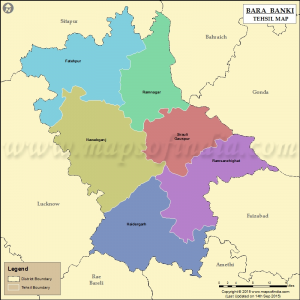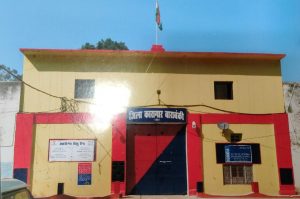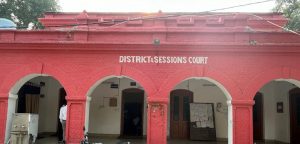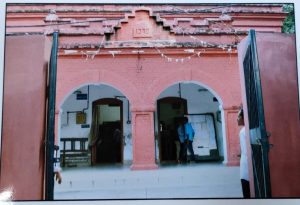History
Barabanki- A Glimpse
The district of Barabanki, lying in the heart of the Avadh region, was created as a separate unit of revenue administration in 1856. Originally known as Daryabad, the headquarter was shifted to Nawabganj (Barabanki) in 1859. Post creation, the areal expanse of Barabanki increased with the transfer of Parganas of Bhitauli, Dewa, Kursi, Haidergarh, and Subeha from the adjoining districts of Bahraich, Lucknow, Raebareli and Sultanpur.
The present areal stretch of the district extending over an area of 3891.5 square kilometers, comprises 1845 villages, one Nagar Palika Parishad, 06 tehsils, and 24 police stations. Representation in the highest democratic institutions is ensured through One Lok Sabha and Six Legislative Assembly constituencies. In the natural realm, the district can be divided into five physical regions, the Ghagra – Chauka (Sarda) doab, the Ghagra flood plain (terai), the central uplands, the trans-Gomati tract, and the Gomati flood plain.

Present Day Barabanki
Legal History:
The pre-British period judicial system under the Nawabs which was based on Muslim Law was replaced after 1858 by the adversarial System of administration of justice made operational through the organized structure of civil and criminal courts. At the inception stage, for the administration of civil justice, Barabanki was under the jurisdiction of District Judge, Lucknow. In 1930 a separate District Judge, who also functioned as District Registrar was appointed for Barabanki. A.C. Bose was the first District Judge of Barabanki. Originally, the District Judge, in addition to exercising administrative control, heard civil and criminal appeals and tried sessions cases. Besides a civil judge for deciding ordinary civil suits of higher valuation, temporary Civil and Sessions Judges and two Munsifs with jurisdiction over Barabanki and Ramsanehighat were also designated. In the domain of criminal justice, there were thirteen stipendiary Magistrates, Deputy Collectors, judicial officers, Tahsildars, and two honorary Special Magistrates with first-class powers. The functional jurisdiction and nomenclature with separation of powers between the judiciary and executive, particularly post the Code of Criminal Procedure, 1973 has undergone perceptible changes, in that distinct functional, command, and control structure has been created for the judicial and executive domain of criminal justice administration.
Present Day Establishment of District Judiciary:
The present District Court situated at the District headquarter at Barabanki has a sanctioned strength of 44 Judicial Officers. In an expression of the intent and effort to decentralize the administration of justice and remove the physical barriers for access to justice, two outlying courts of Civil Judge (Junior Division), Haidergarh sitting at Haidergarh and Ram Sanehi Ghat sitting at Barabanki are also functional. Besides, two Gram Nyayalaya, presided by Nyayadhikari have been made functional at Ramnagar and Sirouli Gauspur. Besides one court of Gram Nyayalaya for the tehsil at Fatehpur has also been created.
The District & Sessions Judge, Barabanki is the administrative head of the district justiciary and is at the top of the hierarchy. Besides, there are sanctioned posts of fifteen Additional District & Sessions Judges, exercising original, appellate, or revisional jurisdiction depending upon the judicial function assigned to the courts. At the secondary level of the District judicial ecosystem, there are eleven sanctioned courts of Civil Judges (senior division)/Chief Judicial Magistrate/ Additional Chief Judicial Magistrates. At the base of the judicial pyramid, there are fifteen sanctioned posts of Civil Judges (junior division)/ Judicial Magistrates, including two posts of Special Judicial Magistrates.
A separate Family Court establishment, comprising of Principal Judge and two Additional Principal Judges, Family Court has also been made functional. In addition, a separate Motor Accident Claims Tribunal is also in existence, providing specialized judicial service to the litigants.
The support staff in the form of court officials are not only essential constituents but have a great role to play in the process of delivery of judicial services and to carry out varied functions. The district judiciary of Barabanki has a sanctioned strength of 408 class III and IV staff. Even though the present working strength exists only at 252, efforts are made to provide the best possible services.
At the end of 2021, there were 1,15,212 cases pending before the District Court and the pendency in the Family Courts was 5190. During the year 2021, while 21,243 cases were disposed of by all courts in the Civil Court, the disposal by the Family Courts was 3168.
The Bar
Another essential constituent of the adversarial legal system as is operative in our country – the Bar at Barabanki has also a chequered history. ‘Pragati’, the Souvenir published by the District Bar Association, Barabanki states that the Association was established in 1904 (Gazetteer states 1923), with Pandit Kanhaiya Lal Shukla as its first President. From 23 members in 1923, the strength of the registered Advocates with District Bar Association has gone up to 3201 in January 2022. Some of the leading lights at the Bar from Barabanki have been Vishnu Narayan Das, Sardar Hussain, Haider Hussain, Durga Dayal, Krishnanand Khare (involved in the drafting of the Land Tenancy Act), Girija Nand Shukla, etc. The legal community from the district has also played a key role in the freedom movement. This is reflected from the fact that Barrister Badshah Hussain was convicted for participation in the Khilafat Movement and Rai Bahadur Kripa Shankar Hajela was part of the defense team for the legendary freedom fighters- Ram Prasad Bismil and Ashfaquallah Khan in the ‘Kakori Train Robbery Case’.
District Jail
Another important constituent of the Criminal Justice Administration – the District Jail, Barabanki was established in the year 1861. Starting with an area of 29.9 acres and capacity to accommodate 403 inmates, it has expanded over an area of 62.53 acres, with the capacity to house 960 inmates. As on 28.01.2022, there were 1389 inmates (144.68 percent of total capacity), comprising of 1084 under-trials and 245 convicted prisoners under incarceration. There were a total of 59 women inmates comprising of 53 under-trials and 06 convicted women prisoners. There were 10 children under 06 years of age staying with the women prison inmates. Sincere efforts for proper reform, rehabilitation, and mainstreaming of the inmates, are being made through the Prisoners Welfare Cooperative Society; programmes for education and skill development, and the IGNOU center for distance education.

District Jail, Barabanki
The Court Infrastructure:
The physical infrastructure of the District Court Barabanki is a beautiful amalgamation of the old and the modern. The hub and the nerve center of the judicial administration, the District Judge Block was constructed way back in the year 1900. It has now been declared and given the status of the heritage building of similar vintage and design is the Civil Block, which was constructed in the year 1908. Besides, there are 06 other blocks, with the latest addition being the FTC Block I, II & III completed in the year 2008-2009. A still later addition is the Conference Hall/Meeting Hall of the District Judge, which is in the process of being shortly completed. Presently, the constructions at the District Court can be classified as District Judge Block, the Civil Court Block, Nazarat Block, Munsif Block, Nayay Bhawan Block and FTC Block I, II & III.



Heritage Building of District Judge Block, Barabanki
Computerization:
The use of Information and Communication Technology (ICT) at all levels in the Indian Judiciary has been introduced and continued in phases to enhance judicial productivity both qualitatively and quantitatively, as also to make the justice delivery system affordable, accessible, cost-effective, transparent and accountable. The seminal report of the E-Committee under Hon’ble Justice G C Bharuka on Strategic Plan for Implementation of Information and Communication Technology in Indian Judiciary presented to the Hon’ble Chief Justice of India in 2005, paved the way for the long-enduring process of application of ICT in the judiciary. Barabanki judgeship got initiated in this process with the inauguration of the e-Judicial Service Center on 24 July 2010. Sincere efforts are made to provide timely and accurate data through the CIS on the NJDG portal. In this process like any other district of the state, all judgments, important orders are made available on the portal, SMS services, mobile apps named e-Court services, computer-generated cause lists, training to officers and staff, etc. have had been under continuous implementation. A centralized e-filing system, along with the e-Payment website URL:https://pay. courts.gov.in has been put in place for easy filing of cases and depositing of various fees and fines respectively. The use of video conferencing for judicial work, training purposes and meetings is also been intensively utilized. The utility of ICT particularly in conducting the court proceedings through the virtual mode during the first and second wave of Covid-19 pandemic induced restrictions especially proved to be of great utility. The process of computerization and digitization under the command and guidance of the E-Committee Hon’ble Supreme Court of India and Hon’ble Allahabad high Court shall continue unabated with commitment.
Computer Section, District Court, Barabanki
Pendency Level
The institution of the judiciary has over the years and particularly under the constitutional scheme of equal justice performed commendably. The High Court of Judicature at Allahabad, established in 1866 has been putting stress on timely, effective and efficacious justice. With changing socio-economic aspirations of the people, litigation has multiplied. Despite commendable achievements in terms of record disposal of cases against various odds, the challenge is and should be zero pendency. For the achievement of this goal, all stakeholders and particularly the judges, the Bar and the police have to put in concerted and coordinated efforts. Citizens approach the court only when there is confidence in the system and faith in the wisdom and neutrality of the judges. The institution stands on the faith of the people. The huge pendency which has at the pan Indian level gone beyond four crore cases, particularly the matters pending for more than five years should be one of the priorities for immediate focus.
As per the data analyzed and emphatically brought to the notice of the judicial officers of all districts of Uttar Pradesh, including Barabanki, by Hon,ble the Chief Justice, Allahabad High Court in the first week of January 2022, while there were a total of 1,07,367 civil and criminal cases pending in Barabanki, the cases older than five years was 40,727, constituting 37.93 percent of the total. The more worrying factor is with respect to 1,651 civil and criminal cases that have been pending for over twenty years, with the oldest case being of 1971 i.e. for more than fifty years. It may also be pointed out that of the total pendency (1,07,367) a total of 66,660 cases were up to five years, constituting 62.80 percent. As per the desire and expectations of Hon’ble the Chief Justice, the judicial officers under the leadership of the District Judge, Barabanki are and would be making sincere efforts to tackle the pendency with priority to old cases.
Some Landmark Judgments:
For a litigant, his matter is the one that is of paramount importance, but from the perspective of the society and the nation, cases have wider implications on the society in the context of impact on the societal fabric. While it is very difficult to select any particular case but keeping in mind the great struggle for independence and criminal case of old vintage, two cases are being mentioned.
1. Case no. 62 of 1922-King Emperor v Badshah Hussain
In this case under Section 17, Act 14 of 1908 (Indian Criminal Law Amendment Act,1908), on the accused admitting of being a member of the National Volunteer Association (declared
unlawful) and that he signed the volunteer pledge, with full knowledge of its consequences, the court convicting the accused sentenced him to simple imprisonment for six months and a fine of Rs. 200/.
Conviction order passed against Badshah Hussian on 10.01.1922
2. Sessions Trial No. 06 of 1935-King Emperor v Bhagwandin Teli
In one of the oldest cases tried by the Barabanki Sessions Court, the accused Bhagwandin Teli was tried under sections 302 and 307 IPC, on the allegation of having murdered his widowed mother Mst. Birja. The court of Humaun Mirza, the then Sessions Judge, Barabanki on conviction awarded the death penalty to the convict on 17 May 1935. The sentence was confirmed by the Chief Court of Oudh in Criminal Appeal No. 281/1935 by the Division Bench comprising of then Chief Justice, Hon’ble Mr. Justice C M King, and Hon’ble Justice HG Smith decided on 02 August 1935.
Confirmation of Death sentence by the Division Bench, Chief Court of Oudh at Lucknow dated 02 August, 1935.
3. In Regular Suit No. 39 of 1930, before the Subordinate Judge, Barabanki – Sirtajulaisa W/o Sri Umadali vs. Maharaj Bux Singh & others filed with respect to mortgage deed, dated 05.12.1924, and for recovery & Rs. 6352/ 15/- principal & interest, was part the preliminary decree passed on 27 October 1930 was made absolute for sale on 25 July 1931.
Preliminary Decree in Mortgage Suit made Absolute(25 July, 1931)
Artefacts, Antiquities of Historical Importance available in the District Court:
Two artefacts of historical importance connected with the traditions of the judiciary as are preserved at District Court, Barabanki may be mentioned. One is the ‘Gangajali’-a bronze pot with the stored holy water of the Ganges was used for administering oaths to witnesses with Hindu religious beliefs appearing in the court of the Sessions Judge Barabanki. Likewise, a manuscript of the Holy Quran written in the year 1902 as used for administering oaths to the Muslim witnesses appearing in the Sessions court Barabanki is another prized treasure.
Bronze Pot Manuscript of Holy Quran
Revenue Administration:
The modern and contemporary phase of the revenue administration of Barabanki can be said to have started with the annexation of Avadh in 1856. Followed by the three regular settlements for conferment of proprietary rights over agricultural land of 1861, 1892 and 1923, post-Independence proprietary rights over agricultural land have been primarily determined through and under the U.P. Zamindari Abolition and Land Reforms Act, 1950 (now U.P. Revenue Code, 2006) and U.P. Consolidation of Holdings Act, 1953. The right and interests of the agriculturists are being administered judicially from the Tehsils to the District level by the existing hierarchy of Revenue administration.
During the year 2021, while 3,72,875 cases were instituted before the revenue courts, 3,30,221 cases were disposed of, the number of cases that were pending as of 31.12.2021 was 42,654.
In one of the widely publicized decisions of the court of SDM/ Assistant Collector, Barabanki-Case No. 162(11-12) of 2012 u/s 41, Land Revenue Act, in Smt Aishwarya Rai Bachhan Inter College Through Amitabh Bachhan Sewa Sansthan Vs. Chaman Singh and Ors., the case pertaining to boundary dispute was decided in favour of the plaintiff.
Cultural Realm
The cultural plurality, which is the hallmark of modern India governed by its Constitution, is beautifully reflected in Barabanki. The continued syncretic tradition is evident in the teachings of Sufi Saint Waris Ali Shah, who professed – ‘You and I are the same’. The symbol of this ‘oneness of faith’ is depicted by the Dargah of Waris Ali Shah at Dewa Sharif in Dewa, Barabanki, which is visited in equal numbers by Hindus and Muslims.
Dewa Sharif Dargah, Barabanki
The temple of Lodheshwar Mahadev at Mahadeva is taken to be associated with the Pandavas. A much revered deity of the worshippers of the nearby districts, Kanwariyas in large number carries the holy water from Ganges river to the Shivlinga at this temple.
A unique floral treasure of the district is the Parijaat tree at Kintur village, 38 kilometers to the east of the District headquarters. Kintur has derived its named from Kunti, mother of Pandavas. Considered to be a type of Kalpvraksh, it is one of a kind tree anywhere in the world. In botanical terms, Parijaat is known as Adansonia digitata and has been kept in a special category in that it is a unisex male tree, which does not produce either fruit or its seeds, neither can its branch cuttings be planted to reproduce a second Parijaat tree. The tree blossoms occasionally after the ‘Ganga Dashehra; to produce a unique flower with five petals of white colour, which dries out to take a golden tinge. The trunk of the tree which is around 50 feet and around 45 feet high is said to be 1000 to 5000 years old.
Parijaat Tree, Barabanki
Prominent Personalities:
The fertile tact of Barabanki known for its rich horticultural produce in the sphere of agriculture, has also been associated from ancient times with some great personalities. For ages, beginning with the mythological and Puranic tradition, Sage Vishvamitra and King Yudhistara have been associated with Satrikh and Dhameri. Starting from the early medieval period, great scholars like Maulana Salah-ud-din, Shaikh Daniyal, Zain-ud-din, Shaikh Ahmad Abdul Haq etc. from Barabanki have made immense contributions to Persion and Urdu literature. Besides, Baba Jagjivan Das, Holrai, Shaikh Abdul Quddus Gangohi and Basharat Ali ‘NADEEM’ are some other notable scholars of Sanskrit and Persian literature. Continuing this tradition, the oldest known weekly of the district – ‘ADHYAPAK’, was started in 1928 and contemporary scholars like Khumar Barabankvi (Mohd. Haider Khan) and Maulana Majid Daryabadi have continued to carry the baton of great literary works.
In the political and social milieu, Rafi Ahmed Kidwai and Mohsina Kidwai have been the torchbearers.
Legendary hockey player Kunwar Digvijay Singh (K.D. Singh Babu) captain of the Indian Hockey team that won the gold medal for the country in the 1952 Olympics (Helsinki) was also born at Barabanki. He is considered by many to be the all-time greatest dribbler of field hockey.
K.D.Singh Babu in Action
The much acclaimed film and theater personally, Padma Bhusan Naseeruddin Shah, winner of many awards of national & international repute was also born at Barabanki on July 20, 1950.
In recent years, the innovative and entrepreneurial farmer from Daulatpur village in Barabanki-Ram Saran Verma, has acquired international fame for growing red bananas, hybrid tomatoes, mint and for having successfully adopted innovative techniques resulting in a manifold increase in productivity with enhanced soil fertility. Besides various Indian Farm awards, he has also been conferred with Padma Shri in 2019.
References –
1. Utter Pradesh District gazetteers Barabanki, published by the Government of Utter Pradesh, 1964.
2. Records of decided cases available in the Record Room, Civil Court, Barabanki.
3. Government of Uttar Pradesh website https://barabanki. nic.in.
4. National Portal of courts in India – https://district.ecourts. gov.in.
5. ‘Pragati Smarika’ ; published by the District Bar Association, Barabanki on completion of 100 years.
6. Informations provided by Jail Superintendent, District Jail, Barabanki and the District Administration, Barabanki.
7. Interviews with Lawyers and Officials of District Court, Barabanki.
8. Different relevant sites on the INTERNET.



